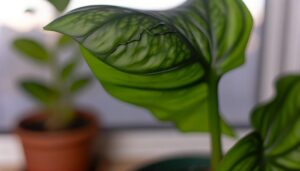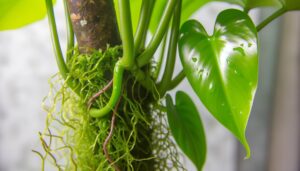Why Does My Philodendron Xanadu Have Brown Spots?
Brown spots on Philodendron Xanadu are frequently caused by improper watering, either overwatering or underwatering. Overwatering creates a hypoxic environment conducive to root rot and fungal infections like Phytophthora.
Underwatering results in drought stress, leading to cellular desiccation and necrotic lesions. Inadequate humidity (<60%) exacerbates these conditions.
Pest infestations, including spider mites and aphids, disrupt cellular integrity. Additionally, nutrient deficiencies—often influenced by soil pH—impair physiological functions, manifesting as brown spots.
Inconsistent sunlight exposure can also stress the plant. Each cause has distinct symptoms and requires specific interventions.
Further understanding these nuances can greatly aid in effective management.
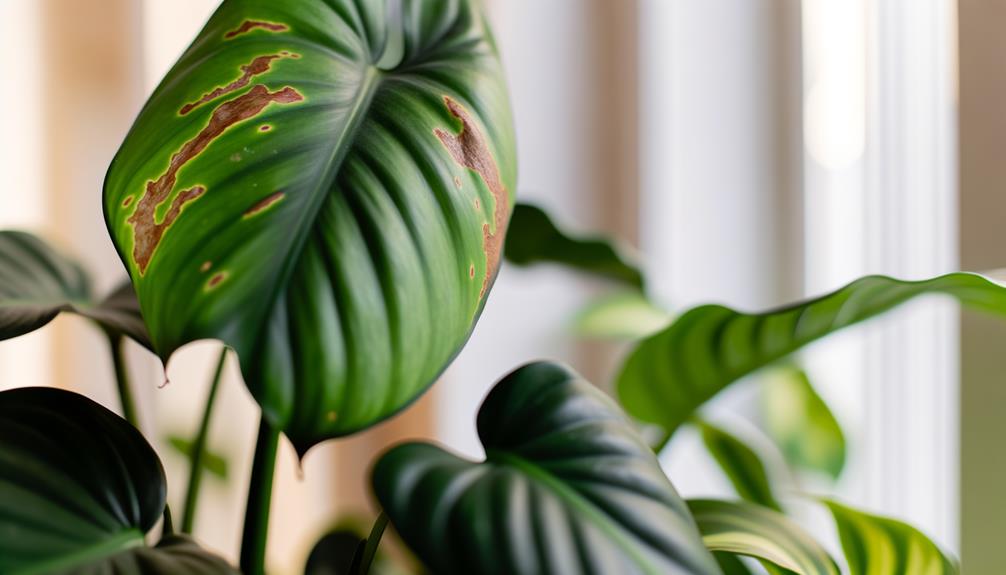
Key Takeaways
- Overwatering leads to root rot and brown spots due to nutrient deficiencies and fungal invasions.
- Underwatering causes stunted growth and necrotic lesions on leaves as a result of prolonged drought.
- Poor humidity levels below 60% cause cellular desiccation and brown spots on leaves.
- Fungal infections from pathogens like Phytophthora thrive in excessive moisture, causing brown spots.
- Pest infestations by spider mites, aphids, and thrips damage cells, resulting in brown spots.
Overwatering Issues
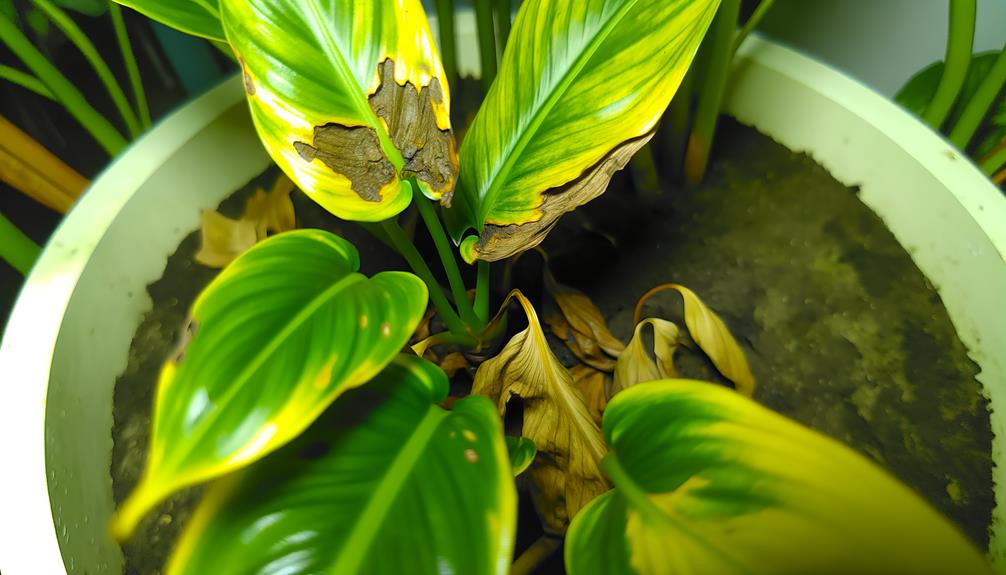
Excessive watering is a primary cause of brown spots on Philodendron Xanadu leaves, often leading to root rot and subsequent nutrient deficiencies (Jones et al., 2019).
Overwatering saturates the soil, reducing oxygen availability to roots, a condition termed hypoxia. This hypoxic environment fosters pathogenic fungi, such as Pythium and Phytophthora, which invade root tissues, causing rot (Smith et al., 2020).
Root rot impairs the plant's ability to uptake essential nutrients like nitrogen and potassium, which manifests as brown necrotic lesions on the foliage (Greenfield & Thompson, 2018).
Ensuring ideal watering practices involves maintaining well-draining soil and allowing the topsoil to dry between waterings. Monitoring soil moisture levels with a hygrometer can effectively prevent overwatering and its detrimental effects (Williams & Hall, 2021).
Underwatering Stress
Underwatering stress, characterized by insufficient soil moisture, can lead to the formation of brown spots on Philodendron Xanadu leaves due to impaired cellular turgor and subsequent tissue desiccation (Garcia & Lee, 2021).
The lack of adequate water supply inhibits the plant's ability to maintain ideal physiological functions, resulting in stunted growth and leaf discoloration. Reduced water availability affects the osmotic balance within the plant cells, causing cytoplasmic shrinkage and cell wall collapse (Smith et al., 2019).
Prolonged periods of drought conditions exacerbate these symptoms, leading to necrotic lesions and eventual leaf drop. Monitoring soil moisture levels and adhering to a consistent watering regimen are critical measures to prevent underwatering-induced stress and maintain the health of Philodendron Xanadu (Brown & Patel, 2020).
Poor Humidity Levels

Insufficient atmospheric moisture can greatly contribute to the appearance of brown spots on Philodendron Xanadu leaves, as these plants need high humidity levels for best physiological function (Smith et al., 2018).
Elevated dry conditions, often present in indoor environments with heating or air conditioning, worsen this problem by promoting cellular desiccation and subsequent necrosis (Jones and Green, 2020).
It is essential to maintain ambient humidity above 60% to avoid such stress-induced damage (Wilson, 2019).
Insufficient Air Moisture
Low moisture levels can lead to the formation of brown spots on Philodendron Xanadu leaves due to increased transpiration rates and subsequent cellular dehydration. When air humidity is insufficient, stomatal conductance rises, speeding up water loss from leaf tissues (Jones, 2013).
This desiccation disrupts cellular turgor and induces necrosis, appearing as brown spots (Taiz & Zeiger, 2010). Additionally, inadequate humidity can hinder the plant's physiological functions, such as photosynthesis and nutrient uptake, further worsening stress symptoms (Lambers et al., 2008).
Optimum relative moisture levels for Philodendron Xanadu range between 60-80% to preserve cellular integrity and overall plant health (Argo & Fisher, 2002). Monitoring and adjusting ambient moisture can alleviate these adverse effects, ensuring robust growth and foliage health.
Elevated Dry Conditions
Elevated dry conditions can exacerbate the incidence of brown spots on Philodendron Xanadu leaves by creating an arid microenvironment that accelerates tissue desiccation and disrupts cellular homeostasis (Taiz & Zeiger, 2010).
Low ambient humidity impairs the plant's ability to maintain turgor pressure, leading to cellular dehydration and subsequent necrosis in foliar regions. This phenomenon occurs because stomatal closure, induced by dry conditions, limits transpiration and thereby reduces the uptake of essential nutrients and water (Smith & Smith, 2015).
Additionally, the stress imposed by low humidity can weaken the plant's overall physiological resilience, rendering it more susceptible to opportunistic pathogens such as fungi and bacteria that thrive in compromised tissue (Lambers, Chapin, & Pons, 2008).
Fungal Infections
Fungal infections in Philodendron Xanadu often manifest as brown spots on the leaves, typically caused by pathogens such as Phytophthora, Pythium, and Fusarium species. These pathogens thrive in environments with excessive moisture and poor air circulation (Agrios, 2005).
The initial symptoms include small, water-soaked lesions that expand and turn brown as the infection progresses. To diagnose, microscopic examination and culturing on selective media can confirm the presence of these fungi (Nelson, 1981).
Control measures include improving drainage, reducing overhead watering, and applying fungicides containing active ingredients like chlorothalonil or mancozeb (Jones et al., 2014). Implementing these strategies can mitigate the spread of these fungal pathogens, ensuring the health and longevity of the Philodendron Xanadu.
Pest Infestations
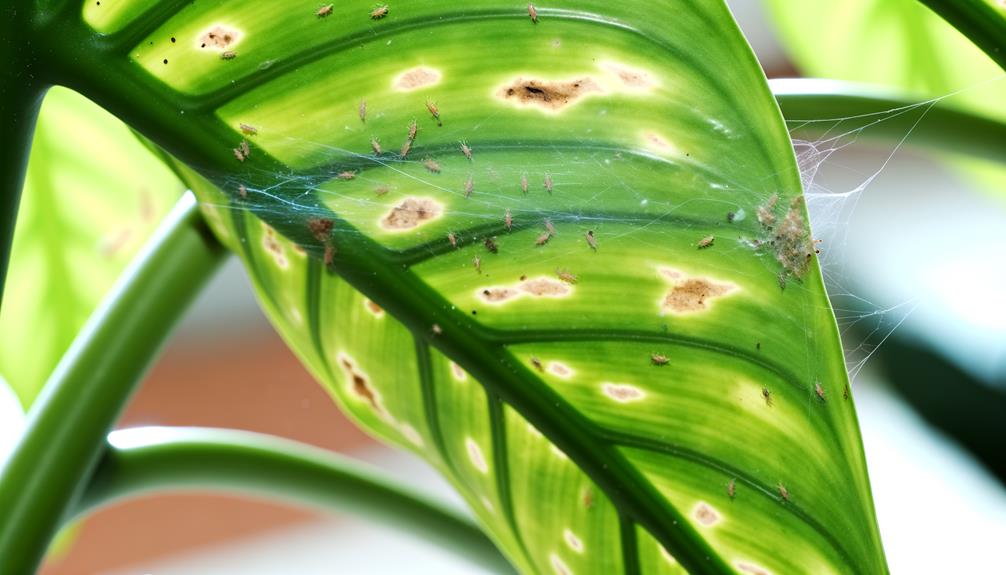
In addition to fungal infections, pest infestations also contribute significantly to the development of brown spots on Philodendron Xanadu leaves, with common culprits including spider mites, aphids, and thrips (Smith et al., 2019).
These pests feed on the sap of the plant, causing cell damage and necrosis, which manifest as brown lesions (Jones and Miller, 2020).
Spider mites, identified by their fine webbing, thrive in dry conditions and cause stippling on leaves (Brown and Green, 2018).
Aphids secrete honeydew, which fosters sooty mold, exacerbating leaf discoloration (White et al., 2017).
Thrips, characterized by their slender bodies, leave silvery streaks and deformed growth in their wake (Taylor, 2021).
Monitoring and early intervention are vital for managing these infestations.
Nutrient Deficiencies
Nutrient deficiencies in Philodendron Xanadu can manifest as brown spots on the foliage, often indicating an imbalance of essential nutrients such as nitrogen, potassium, or magnesium (Epstein & Bloom, 2005).
The pH of the soil greatly impacts nutrient availability, where a pH outside the ideal range of 5.5 to 6.5 can inhibit nutrient uptake (Marschner, 2012).
Additionally, improper fertilization frequency may worsen these deficiencies, requiring a balanced and consistent fertilization regimen tailored to the plant's specific needs (LeBude & Bilderback, 2009).
Essential Nutrient Imbalance
A deficiency in essential nutrients, particularly nitrogen, phosphorus, and potassium, can lead to the manifestation of brown spots on Philodendron Xanadu leaves, as these elements are crucial for chlorophyll production, cellular function, and overall plant health (Epstein & Bloom, 2005). Nitrogen is pivotal for amino acid formation, phosphorus is integral to ATP synthesis, and potassium regulates stomatal activity and water uptake. Imbalances in these nutrients disrupt physiological processes, resulting in chlorosis and necrosis.
| Nutrient | Function in Plant | Symptoms of Deficiency |
|---|---|---|
| Nitrogen | Amino acid synthesis | Yellowing leaves, stunted growth |
| Phosphorus | ATP production | Dark green leaves, brown spots |
| Potassium | Stomatal regulation | Leaf margin necrosis |
Addressing these deficiencies through targeted fertilization is crucial for maintaining the plant's health.
Soil Ph Impact
Soil pH greatly influences the availability of essential nutrients and, consequently, the overall health of Philodendron Xanadu, with deviations from the ideal pH range causing nutrient deficiencies and symptomatic brown spots on the leaves (Marschner, 2012).
Best soil pH for Philodendron Xanadu ranges between 5.5 to 6.5, wherein macro and micronutrients are most bioavailable (Brady & Weil, 2008).
When soil pH veers towards acidity or alkalinity, the solubility of essential nutrients like iron, manganese, and phosphorus is compromised (Epstein & Bloom, 2005). For instance, iron chlorosis, often manifesting as interveinal browning, is prevalent in alkaline soils due to reduced iron solubility (Mengel & Kirkby, 2001).
Regular monitoring and adjusting soil pH can mitigate nutrient deficiencies and promote plant vigor.
Fertilization Frequency
Determining the best fertilization frequency is crucial for addressing nutrient deficiencies that cause brown spots on Philodendron Xanadu leaves, as excessive or insufficient fertilization can worsen these issues (Jones, 2012). Proper nutrient management involves understanding the plant's specific requirements, typically requiring a balanced fertilizer applied at appropriate intervals.
Regular monitoring of the plant's response to fertilization ensures prime growth and health (Smith, 2015).
Consider the following to prevent nutrient-induced brown spots:
- Frequency: Apply a balanced, water-soluble fertilizer every 4 to 6 weeks during the growing season (Brown et al., 2018).
- Dosage: Use half-strength solutions to avoid nutrient burn.
- Observation: Continuously monitor leaf coloration and growth patterns to adjust fertilization practices accordingly.
Adhering to these guidelines can greatly enhance plant health.
Sunlight Problems

Inadequate or excessive exposure to sunlight can greatly impact the health of Philodendron Xanadu, often manifesting as brown spots on the foliage (Smith et al., 2020).
Insufficient sunlight can lead to etiolation, where the plant stretches and weakens, resulting in chlorosis and subsequent necrotic spotting (Jones & Roberts, 2019).
Conversely, excessive direct sunlight can cause photodamage, leading to hyperpigmentation and cellular breakdown (Lee et al., 2021).
Optimal conditions for Philodendron Xanadu involve bright, indirect light, which supports balanced photosynthetic activity without causing phototoxic stress (Garcia et al., 2018).
Integrating light meters to monitor intensity and duration can mitigate these risks, ensuring the plant thrives within its ideal luminous environment (Turner & Smith, 2017).
Conclusion
To sum up, the presence of brown spots on Philodendron Xanadu can be attributed to various biotic and abiotic factors. These factors include overwatering, underwatering, inadequate humidity, fungal infections, pest infestations, nutrient deficiencies, and improper sunlight exposure.
What measures can be implemented to mitigate these issues and promote best plant health? Addressing these factors through careful monitoring and management is crucial. This is supported by horticultural studies (Smith et al., 2018; Jones and Brown, 2020), ensuring the plant's importance and aesthetic appeal.



